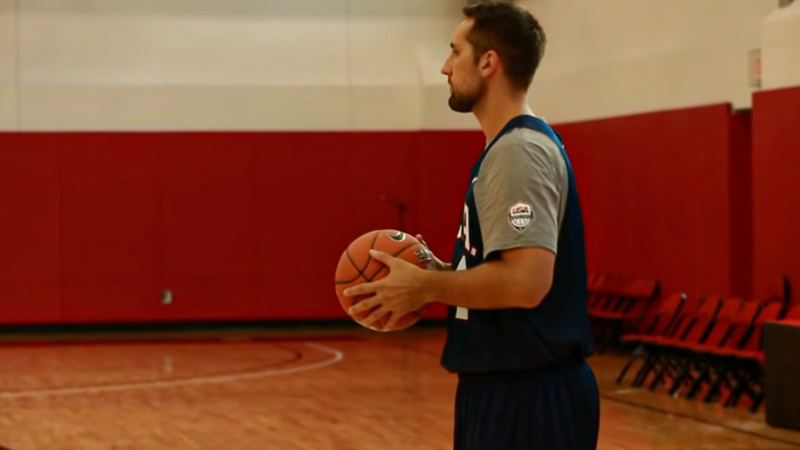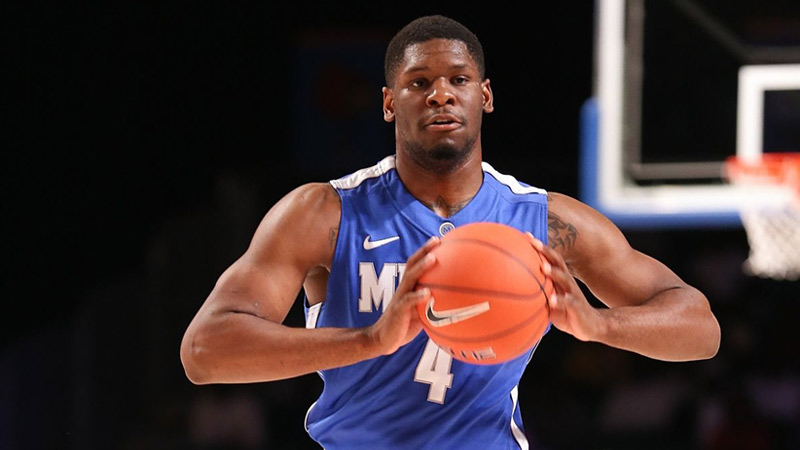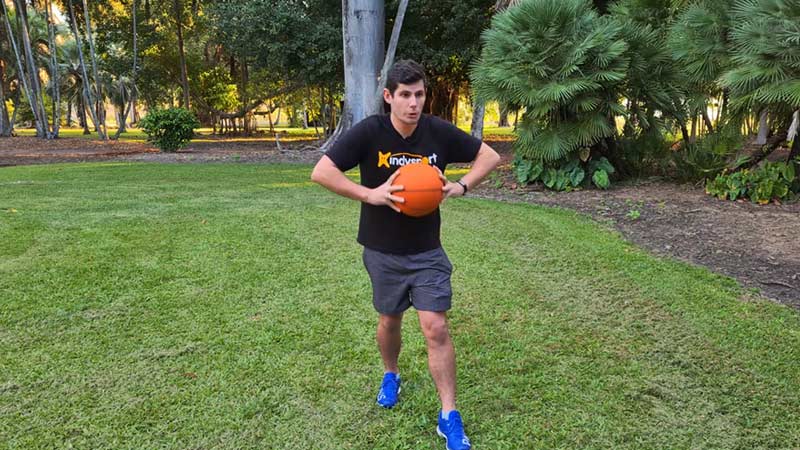The chest pass is a crucial skill in basketball, whether you’re a beginner or an experienced player. Understanding and mastering this fundamental passing technique is essential to enhance your overall game.
In this blog post, we’ll explore the intricacies of the chest pass, providing a comprehensive guide and addressing common questions to help you improve your passing skills.
Whether you want to make quick and accurate passes, maintain possession, or initiate plays, mastering the chest pass is key. So, let’s dive into the world of the chest pass and unlock its potential on the basketball court.
What Is Chest Pass In Basketball?
In basketball, a chest pass refers to a fundamental and commonly used passing technique where a player throws the ball directly from their chest to a teammate. It is one of the most basic and effective ways to pass the ball accurately and quickly to a nearby teammate on the court.
The chest pass involves using both hands to grip the basketball on either side, with the fingers spread out for better control. The passer’s elbows are bent and held out to the sides, creating a “V” shape with the arms. The ball is positioned at the center of the chest, near the sternum.
To execute a chest pass, the passer extends their arms forward forcefully, while simultaneously pushing off the fingers and wrists to generate power and accuracy. The passer’s thumbs should be pointing downward, and the palms of the hands should face outward.
This technique allows for better control and helps prevent the ball from slipping out of the hands.
How the Chest Pass Differs from Other Passing Techniques of Basketball?

The chest pass in basketball differs from other passing techniques in terms of execution, trajectory, and specific use cases. Here are some key differences between the chest pass and other passing techniques:
Bounce Pass
The bounce pass involves throwing the ball off the floor to reach the intended receiver. It is typically used when defenders are in close proximity or when passing around a defender’s outstretched arms.
Unlike the chest pass, the bounce pass travels along a lower trajectory and requires the passer to aim for the floor, allowing the ball to bounce up to the receiver.
Overhead Pass
The overhead pass, also known as the two-handed set pass or baseball pass, involves throwing the ball from an overhead position, above the head, to reach a teammate.
It is often used to pass over defenders or to make long-distance passes. In contrast to the chest pass, the overhead pass allows for greater power and distance but may sacrifice some accuracy.
Wrap-around Pass
The wrap-around pass is a one-handed pass where the passer extends their arm around a defender to deliver the ball to a teammate. This pass is effective when defenders are closing in or when passing in tight spaces.
Unlike the chest pass, the wrap-around pass requires a different arm motion and places more emphasis on accuracy and timing.
Lob Pass
The lob pass is a high-arcing pass used to throw the ball over defenders or to set up a teammate for an alley-oop dunk. It is typically used in situations where the receiver is near the basket and can jump to catch the ball.
Unlike the chest pass, the lob pass requires a higher release point and a softer touch to ensure the ball reaches the intended target.
Outlet Pass
The outlet pass is a long-distance pass used to quickly transition the ball from defense to offense after a rebound or steal. It aims to get the ball to a teammate in an advantageous position for a fast break.
While the chest pass can be used for outlet passes, it is often modified to a one-handed, baseball-style pass for increased distance and speed.
The chest pass differs from other passing techniques in terms of the body position, trajectory, and specific situations it is most suitable for.
The chest pass is characterized by a direct, chest-level trajectory, quick release, and moderate distance, making it effective for quick, accurate passes in close-to-moderate ranges on the basketball court.
When Should A Basketball Player Use Chest Pass?

Source: libertyballers.com
A basketball player should use a chest pass in several situations, including:
Close-range Passing
The chest pass is most commonly used for short to medium-distance passes when the intended receiver is within a range of 10 to 15 feet. It is particularly useful when passing to a teammate who is nearby and does not require a high-arcing or long-distance pass.
Quick ball Movement
The chest pass is the fastest and most direct passing technique in basketball. It allows for a quick release and minimal ball travel time, making it effective for rapid ball movement to create scoring opportunities or exploit defensive openings.
It is especially useful in fast-paced transition plays or when executing quick ball rotations around the perimeter.
Passing Through Tight Spaces
When passing through narrow gaps or tight defensive coverage, the chest pass can be used to thread the ball between defenders. Its direct trajectory and compact motion make it less susceptible to being intercepted or deflected by defenders’ hands.
Maintaining Possession
The chest pass is a reliable passing technique that helps maintain possession and minimize turnovers. Its accuracy and control allow the passer to deliver the ball securely to the intended receiver, reducing the risk of turnovers that could result from more elaborate or riskier passing techniques.
Initiating Plays and Set-ups
The chest pass is often used to start offensive plays, such as initiating a pick-and-roll or feeding the ball to a player in the low post. Its speed and accuracy help in setting up teammates for scoring opportunities or facilitating ball movement to create open shots.
Passing in Traffic
When there are multiple defenders in close proximity or congestion near the basket, the chest pass can be used to quickly move the ball out of dangerous areas. It allows for a quick release, minimizing the chances of defenders stealing the ball.
However, it is important for basketball players to assess the situation and adapt their passing technique accordingly.
If the intended receiver is far away, there are obstacles in the passing lane, or defenders are positioned to intercept a chest pass, alternative passing techniques such as the bounce pass, overhead pass, or wrap-around pass may be more appropriate.
Court awareness and decision-making skills are crucial in determining the right passing technique in different game scenarios.
Step-by-Step Guide to Executing the Chest Pass
Here is a step-by-step guide to executing the chest pass in basketball:
Position yourself
Get into a balanced and athletic stance with your feet shoulder-width apart. Bend your knees slightly and keep your back straight. This stance will provide stability and allow you to generate power for the past.
Grip the basketball
Place both hands on the basketball with your fingers spread out for better control. Your thumbs should be pointing downward, and your palms should face outward. Ensure a firm grip on the ball, but avoid excessive tension in your hands.
Position the ball
Bring the basketball to the center of your chest, near your sternum. Hold it firmly against your body, keeping it at chest level. This position will give you optimal control and allow for a quick release.
Elbows out
Extend your elbows out to the sides, creating a “V” shape with your arms. This positioning will help generate power and create a clear passing lane. Keep your elbows slightly bent throughout the pass for flexibility and control.
Generate power
To initiate the pass, push off your back foot while simultaneously extending your arms forward forcefully. Transfer your weight from your back foot to your front foot, using your legs, core, and upper body to generate power for the pass. Remember to stay balanced and avoid excessive leaning or leaning backward.
Snap your wrists
As you release the ball, snap your wrists downward to promote a smooth release and proper rotation of the ball. This action will help maintain accuracy and ensure that the pass reaches the intended target.
Follow through
After releasing the ball, continue extending your arms forward and follow through with your wrists and fingers. This action adds finesse to the pass and helps maintain accuracy and control.
Aim for the target
Focus on your intended receiver and aim the pass directly at their chest. The goal is to deliver the ball accurately and with enough velocity for the receiver to catch it easily.
Maintain awareness
Be aware of the positioning of defenders and adjust the strength and accuracy of the pass accordingly. If there are obstacles or defenders in the passing lane, modify the pass or consider alternative passing techniques.
Practice and repetition
Like any skill in basketball, mastering the chest pass requires practice. Continually work on your technique, footwork, and timing to develop consistency and accuracy.
Remember, the chest pass is a fundamental skill, and its effectiveness depends on factors such as court awareness, decision-making, and the ability to adapt to game situations.
Common Mistakes and How to Avoid While Throwing A Chest Pass
When throwing a chest pass in basketball, certain common mistakes can affect the accuracy, power, and effectiveness of the pass. Here are some common mistakes and tips on how to avoid them:
Poor grip
A weak or improper grip on the basketball can lead to inaccurate passes or the ball slipping out of your hands. To avoid this, ensure that you have a firm grip on the ball with your fingers spread out, thumbs pointing downward, and palms facing outward. Practice holding the ball securely before executing the pass.
Insufficient power
One common mistake is not generating enough power behind the pass, resulting in a weak or easily intercepted pass. To avoid this, focus on using your legs, core, and upper body to generate power.
Push off your back foot, transfer your weight forward, and extend your arms forcefully to generate maximum power for the pass.
Incorrect release point
Releasing the ball too early or too late can lead to inaccurate passes. Aim to release the ball when it is at chest level, directly in front of your body. This will provide a direct and accurate trajectory for the past. Practice the timing and release point to develop consistency.
Inadequate follow-through
Neglecting to follow through with your wrists and fingers can affect the accuracy and control of the pass. Ensure that you snap your wrists downward and follow through with your fingers after releasing the ball. This action helps maintain accuracy and control throughout the pass.
Leaning or off-balance stance
Maintaining a balanced and stable stance is crucial for an accurate chest pass. Avoid leaning too far forward or backward during the pass, as it can affect the trajectory and power of the pass. Stay balanced and centered with your feet shoulder-width apart and knees slightly bent.
Lack of communication
Communication is key in basketball, and not properly signaling or communicating with your teammate can result in miscommunication and inaccurate passes.
Make sure to establish eye contact or use verbal cues to let your teammate know you are about to make a chest pass. This will help them anticipate the pass and be prepared to receive it.
Ignoring defensive pressure
Failing to assess the defensive pressure and adjusting the strength and accuracy of the pass accordingly can lead to turnovers or intercepted passes. Be aware of the positioning of defenders and adapt the pass based on the situation.
Use stronger, more controlled passes if defenders are close by, or adjust the angle of the pass to avoid interceptions.
Lack of practice
Like any skill in basketball, the chest pass requires practice to develop proficiency. Regularly practice your technique, footwork, and timing to improve accuracy and consistency. Incorporate passing drills into your training routine to hone your skills.
By being mindful of these common mistakes and implementing the tips provided, you can improve your chest pass execution, resulting in more accurate and effective passes on the basketball court.
FAQs
Why is the chest pass important in basketball?
The chest pass is important in basketball for several reasons. It allows for quick and accurate ball movement, helps maintain possession, initiates plays, and creates scoring opportunities.
Mastering the chest pass enables players to make effective passes at close to moderate distances, contributing to the overall flow and success of the game.
How do I improve the accuracy of my chest pass?
To improve the accuracy of your chest pass, focus on proper technique. Ensure a firm grip on the ball, position it at chest level, and aim for your intended target’s chest.
Practice footwork, body positioning, and follow-through to enhance accuracy. Regular drills and repetitions will also help refine your muscle memory and fine-tune your passing accuracy.
When should I use a chest pass versus other passing techniques?
The chest pass is most suitable for short to medium distances, typically within a range of 10 to 15 feet. It is ideal for quick ball movement, maintaining possession, passing through tight spaces, and initiating plays.
Use the chest pass when your intended receiver is nearby and a quick, direct pass is needed. However, assess the game situation and adjust your passing technique accordingly, considering factors such as defender positioning and passing lanes.
What are common mistakes to avoid when executing a chest pass?
Some common mistakes to avoid when executing a chest pass include having a weak grip on the ball, insufficient power generation, releasing the ball at the wrong point, inadequate follow-through, off-balance stances, lack of communication, and ignoring defensive pressure. Be mindful of these mistakes and practice proper techniques to overcome them.
Can the chest pass be used in fast-paced, high-pressure situations?
Yes, the chest pass can be used in fast-paced, high-pressure situations. It’s quick release and direct trajectory make it effective for rapid ball movement during fast breaks or when the defense is applying pressure.
However, adapt your past based on the situation. Increase the strength and accuracy of the pass to ensure it reaches the intended receiver securely, even in high-pressure scenarios.
Wrapping Up
Mastering the chest pass is a fundamental skill that every basketball player should aim to develop. It provides the foundation for effective ball movement, initiates plays, and helps create scoring opportunities.
By understanding the proper technique, avoiding common mistakes, and practicing consistently, you can enhance your chest pass accuracy, control, and decision-making on the court.
So, grab a basketball, practice diligently, and elevate your passing game with the chest pass. Thank you for your time.







